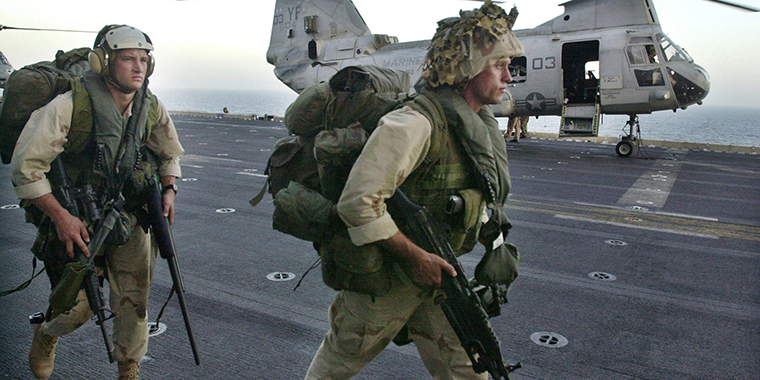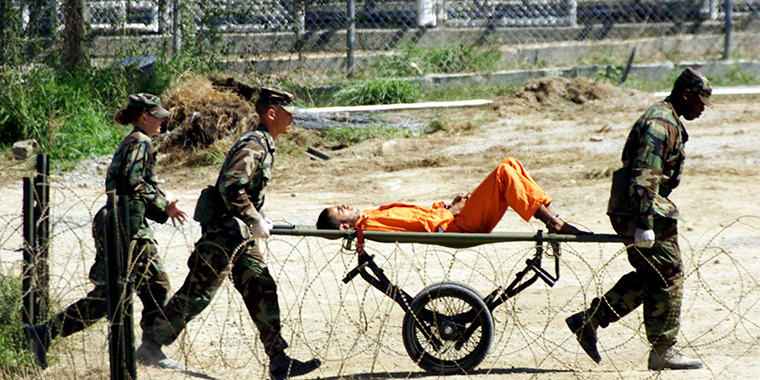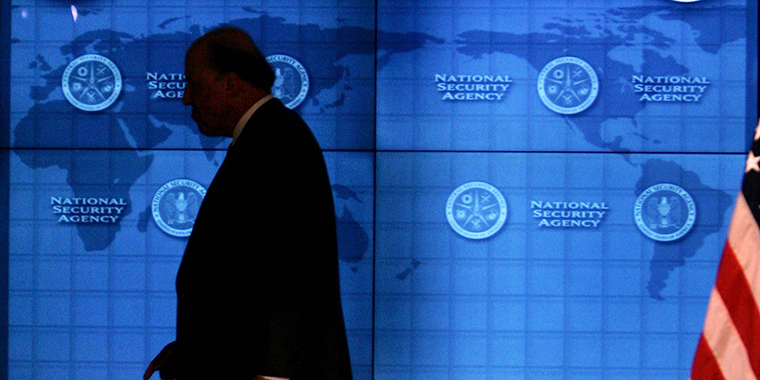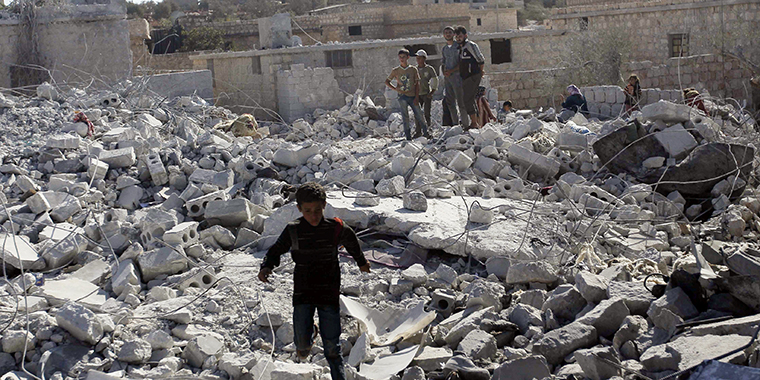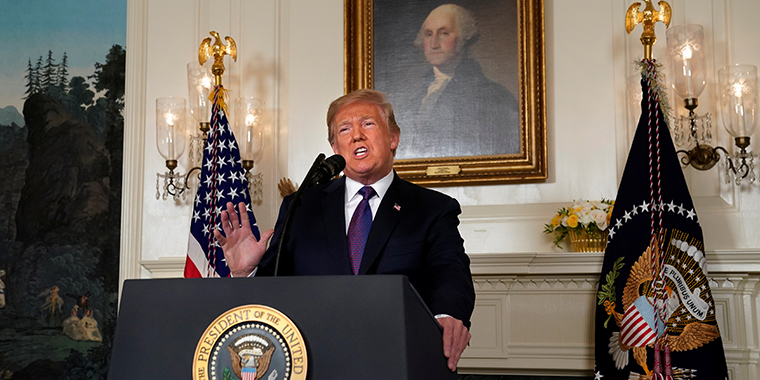How a Single Phrase Defined the War on Terror
What is the 2001 AUMF and what does it have to do with 9/11? From the invasion of Afghanistan, to the Iraq War, and more, learn how the United States justified U.S. counterterrorism policy for over two decades.
On the morning of September 11, 2001, two hijacked planes crashed into the twin towers of the World Trade Center, a third struck the Pentagon, and a fourth was headed for Washington, DC, when passengers overtook the hijackers and brought the plane down in Pennsylvania.
The 9/11 attacks targeted the symbolic centers of U.S. business and security. The plane hijackings resulted in the deaths of nearly three thousand people. Following 9/11, Americans’ perceptions of security, privacy, extremism, and geopolitics fundamentally changed. Post-9/11 policies affect the most mundane and most profound aspects of American lives—from boarding an airplane to grappling with the ramifications of drone warfare.
In the chaotic aftermath of the deadliest terrorist incident on record, Congress passed a series of laws reorganizing and empowering U.S. intelligence agencies and the military to combat the threat from terrorism. It is not surprising that the U.S. government enacted these changes in the wake of the attacks. What is striking, however, is how many of those measures have served as the foundation of U.S. foreign and domestic policy for over twenty years.
In particular, the 2001 Authorization for Use of Military Force (AUMF) has been interpreted, many experts say, far beyond its original scope. It served as the justification for counterterrorism policies for almost two decades.
What is an AUMF?
The president is commander-in-chief of the armed forces. However, the White House needs Congress’s permission to use military force abroad for any operation lasting longer than sixty days. Lawmakers can declare war, giving the president broad powers, but that practice is effectively obsolete; Congress issued its last official declaration of war during World War II. Alternatively, Congress can pass a law authorizing a narrower scope of military operations. AUMF laws serve as that authorization, and they typically restrict military action to specific locations and, often, time frames. The 2001 AUMF, however, is so broad that it has been compared to declarations of war. In fact, some argue that this AUMF is even broader than a declaration of war, as the enemy is described, rather than named.
Its open-ended nature means that the 2001 law has been used to justify some of the most significant national security policies and military operations since 9/11.
How was the 2001 AUMF created?
The 2001 AUMF was drafted in the hours after the 9/11 attacks and passed three days later. The sixty-word resolution authorized the president to take action against those responsible for the attacks on September 11:
That the President is authorized to use all necessary and appropriate force against those nations, organizations, or persons he determines planned, authorized, committed, or aided the terrorist attacks that occurred on September 11, 2001, or harbored such organizations or persons, in order to prevent any future acts of international terrorism against the United States by such nations, organizations or persons.
The 2001 AUMF was passed in the midst of a national emergency, and it clearly outlined a military response against those responsible for the attacks. What has become a subject of great debate, however, is how it was used to authorize the actions of subsequent presidential administrations.
Timeline of U.S. military force authorizations post-9/11
The invasion of Afghanistan: 2001
The first major policy step, clearly based on the 2001 AUMF, was the invasion of Afghanistan on October 7, 2001. Launched with support from the United Kingdom, Operation Enduring Freedom targeted al-Qaeda (which “planned” and “committed” the attacks) and the Taliban (which “harbored” al-Qaeda). Osama bin Laden, the founder of al-Qaeda who claimed responsibility for directing the attacks, was ultimately killed by U.S. forces in 2011.
Detaining enemy combatants at Guantanamo Bay: 2001-Present
One month later, Bush, citing his authority under the AUMF, issued a military order outlining his administration’s plans for the detention, treatment, and trial of enemy combatants in the war on terror. His order led to hundreds of alleged al-Qaeda members being detained at Guantanamo Bay, Cuba. The detentions faced legal challenges. However, in 2004 the Supreme Court upheld the president’s authority to detain enemy combatants, calling it a “fundamental incident” of the use of military force. In other words, in a war, preventing a fighter on the other side from returning to the battlefield is part of the deal: by authorizing the war itself, the Supreme Court held, Congress had authorized the natural next step, detention. The AUMF became the main source of presidential authority to detain enemy combatants at Guantanamo Bay.
The groundwork for Iraq War: 2002
In October 2002, Bush convinced Congress to pass another AUMF by arguing that Iraqi President Saddam Hussein was an al-Qaeda ally and that “confronting the threat posed by Iraq is crucial to winning the war on terror.” This additional AUMF, known as the Iraq Resolution, authorized military force in Iraq. However, the 2001 AUMF remained part of the legal foundation for the Iraq War. In a March 2003 letter to Congress announcing the start of the U.S. invasion, Bush quoted the 2001 AUMF: “The use of armed force against Iraq is consistent,” he wrote, with necessary action against “those nations, organizations, or persons who planned, authorized, committed, or aided the terrorist attacks that occurred on September 11, 2001.”
The Terrorist Surveillance Program: 2002–2007
According to the Bush administration, the 2001 AUMF not only authorized military action abroad but also permitted intelligence operations within the United States. In 2005, a New York Times story revealed that the National Security Agency (NSA) had been wiretapping U.S. citizens without warrants since 2002. The monitoring captured international communications that were potentially linked to terrorist activity.
The Bush administration pointed to the AUMF as legal justification for the so-called Terrorist Surveillance Program. Using the Supreme Court’s 2004 ruling on the AUMF, Attorney General Alberto Gonzales equated the necessity of gathering intelligence to the need for detaining enemy combatants. Like the detention of suspected terrorists, the Terrorist Surveillance Program was deemed a “fundamental incident” of using military force.
In response to the ensuing public outcry over privacy concerns, Congress set broad legal constraints on the NSA’s Terrorist Surveillance Program. The program was later significantly rolled back under the Obama administration.
Targeting al-Qaeda’s “associated forces”: 2006-present
In addition to al-Qaeda and the Taliban (clear targets of the 2001 AUMF), the United States has also taken military action against the “associated forces” of those organizations. The phrase “associated forces” is not included in the 2001 AUMF; instead, the Bush administration began using it as a reference to groups fighting alongside al-Qaeda or the Taliban against the United States or U.S. coalition partners.
White House officials have argued that the 2001 AUMF authorizes attacks on these associated forces and have used that argument to support air strikes, targeted killings, and ground operations against groups such as al-Shabab in Somalia, the Islamic State in Khorasan, and al-Qaeda in the Arabian Peninsula in Yemen.
After Bush, the Obama administration continued to target associated forces. The self-proclaimed Islamic State did not exist when the AUMF was passed—in fact, it has been in open conflict with al-Qaeda since 2014. Regardless, the Obama administration considered the Islamic State an associated force and took military action against the terrorist group.
Air strikes against Syrian government: 2017
The Trump administration has also used the 2001 AUMF to defend military actions with increasingly weak justification. After the Syrian government used chemical weapons against civilians in 2017, Trump ordered air strikes against the government forces. Though Syria was not technically part of the original scope of the 2001 AUMF, Paul D. Ryan, then the speaker of the House of Representatives, said the president “has the authority to attack under the existing AUMF.” However, the administration itself did not elaborate why, precisely. This was seen as the latest instance of isolated actions undertaken by presidents, with no backing from Congress or the United Nations. Instead, these decisions— including airstrikes against the Syrian government were covered, however tenuously, by the AUMF.
Is the 2001 AUMF going to be repealed?
In 2015, Obama pressured Congress to pass a new AUMF that would more specifically cover action against the Islamic State. However, lawmakers failed to agree on the scope of any new authorization law. In 2018, a group of senators did introduce draft language for a new AUMF, but it did not impose a time limit or create other significant restrictions. It stalled in the Senate, regardless.
In early 2023, the Senate voted to repeal the law with bi-partisan support. The bill is now with the U.S. House of Representatives, where it is unclear if it will be brought up for a vote. Despite support from President Biden, the executive branch has stated that any repeal would not affect any ongoing U.S. military operations.
In part, the lawmakers who drew up the original text are responsible for its longevity: they did not include any details on how to review the law to make changes or how to terminate it when the mission is complete.
But it’s not just the text of the law that’s broad—it’s also the concept the 2001 AUMF is trying to counteract. While past force authorizations did not always include timing restrictions, they would naturally end when the specified enemy was defeated. But terrorism is not a specific enemy. So how can the U.S. government know when terrorism has been defeated?
The 2001 AUMF is unique in that it authorizes the use of force against not only other countries but also unspecified organizations and individuals connected to international terrorism. It is therefore difficult to determine whether the United States has finally achieved the goal for which military force was originally authorized—or whether the U.S. government has overreached in its effort to prevent future attacks.


